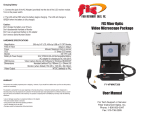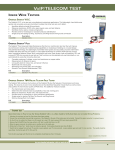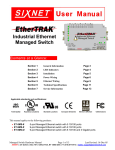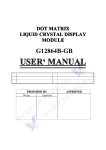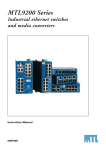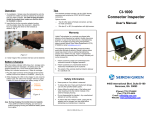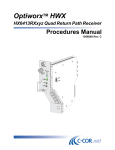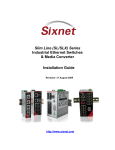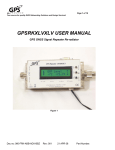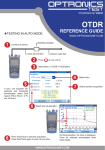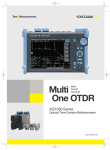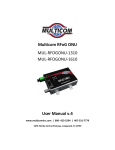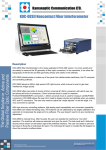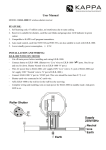Download Userguide Ethernet
Transcript
LEMO 10/100BaseT ETHERNET MEDIA CONVERTER User Manual ® ® This document defines the process of correctly connecting the Ethernet M/C (Media Converter) to a reel of fibre optic cable. The operation of the Ethernet M/C system is also explained. The electrical pin out has been included to allow easy replacement of the electrical cable, if required. Presentation & Warning The LEMO Ethernet to fibre media converter has been designed to ensure reliable conversion in harsh environments. A pair of media converters enables the conversion of signals from Ethernet 100 BaseT copper networks to fibre optics and vice-versa. Using the converter allows the Ethernet signal to be transmitted over a long distance without loss of quality. The advantages are immunity to electro magnetic interference and increased security for sensitive information. Warning: CAUTION Class 1 Laser Product: The Ethernet converter is classified as a CLASS 1 LASER PRODUCT. Do not stare into the beam or view it directly with optical instruments. Instructions for Mating LEMO Fibre Optic Connectors Cleaning Although we endeavour to make sure that all fibre optic product is clean before we send it, there is always a chance that some particle contamination may occur during transit or upon removing the covering. Before the optical interface is made (when the connectors mate) it is essential to ensure that both the ferrule end faces in the cable connectors and in the Ethernet M/C are clean from dirt/dust etc. A separate document (included in the appendix) has been included giving detailed instructions on the cleaning process for LEMO fibre optic contacts. Assembly When satisfied that the fibre optic contacts are clean, the assembly can take place. Below is a picture of the fibre optic plug found on both ends of the fibre optic cable assembly. Both the fibre optic plug, and the Ethernet M/C have imprinted on them a red location dot. In order for the two to mate, the two red dots must be aligned. Due to internal keying, it is impossible to mate the fibre optic plug and the Ethernet M/C in any rotation other than when the two red dots are in line. When mating the fibre optic plug and the Ethernet M/C together, there will be some resistive force introduced by the latching mechanism inside the fibre optic plug, and the o-ring seal inside the Ethernet M/C. Below is a picture of the Ethernet M/C 2 It is important that when mating the two, shoulder of the fibre optic plug meets with the end of the Ethernet M/C and that a noticeable clicking sound is heard, showing that the latches are engaged. www.lemo.com ® ® Operating Instructions Connections for Operation The M/C (Media Converter) requires a 5Vdc supply to power the unit, as well as a 100BaseTX Ethernet connection. The M/C has to be connected to another M/C, or to a 100BaseF fibre optic Ethernet connection, via a fibre optic cable terminated with 3K fibre optic connectors. LED Indicators There are 3 LED indicators on the M/C, Red, Green and Blue. The Blue LED indicates power. The Green LED indicates an active 100BaseT Ethernet copper signal on the copper side. The Red LED indicates an active 100BaseF Ethernet fibre optic signal on the fibre optic side. Constant blue light – power is good Green light – copper signal is good, no fibre signal Red light – fibre signal is good, no copper signal When the system is functioning properly, the Blue LED will remain on constantly, the Green and Red LEDs will flash intermittently with the passing of data packets. Electrical Pin-out The image opposite shows the electrical end of the M/C or LEMO 1K plug end. As you can see, there are 6 contacts, 2 for power and 4 for signal data. LEMO 1K plug end Contacts 1 and 2 are for the power input, 1 being the positive input, and 2 being the negative. 6 6 Contacts 3 and 4 are the twisted pair carrying data into the M/C, 3 being positive and 4 being negative. Ethernet electrical end 5 1 4 5 2 3 Contacts 5 and 6 are the twisted pair carrying signal data out of the M/C, 5 being positive and 6 being negative. www.lemo.com 4 3 1 2 3 ® ® Replacing the Copper Cable If for any reason, the electrical cable needs to be exchanged, the following describes the cable replacement process. Unscrew the collet nut (attached to the strain relief) using a size 15 mm A/F spanner. Unscrew the extender nut using the same spanner. 2 small half shells will come free, and the wires will become exposed. Remove the copper wires from the solder buckets using a soldering iron. Remove from the old cable all the remaining items (the dome shaped ring, the o-seal, the v-shaped ring, the collet, the extender nut, the collet nut and the strain relief boot). Place on the new cable (in the following order) the strain relief boot, the collet nut, the collet, the extender nut, the v-shaped ring, the o-seal and the dome shaped ring. Strip back the cable jacket to the length of the half shells plus an additional 2 to 3 mm. Flay out the braid, and using the dome shaped ring as a guide, cut the braid to the same diameter as the ring. Strip the ends of the copper wires and solder them to the solder buckets on the media converter. Ensure that the TP IN + and – share a twisted pair and the TP OUT + and – share a twisted pair. Place the 2 half shells around the solder joints, and hold in place by screwing on the extender nut. Tighten the extender nut with the spanner and slide all remaining parts down the cable towards the media converter. Tighten the collet nut on the extender nut with a spanner and ensure the strain relief boot is secure on the collet nut. Attach the connector to the opposite end of the new cable using the instructions included with the connector. Test the unit to confirm functionality. Appendix Technical Specifications Characteristics I/O connectors Fibre type Wavelength Package dimensions Mass Temperature range Electrical inputs LD optical output Photodiode sensitivity Data rate Transmission distance MTBF 4 Value Electrical - various, fibre - 3K.03A Single mode 9/125 µm 1310 nm ø 29 mm x 127 mm (169 mm with strain relief) 140 grams -20°C to +85°C 10/100 BaseT Ethernet, 5V supply (280mA) 200 µW (250 µW max.) -37 to -5 dBm 125 Mbps (Max.) above 20 km 1.6 x 10 5 hours www.lemo.com ® ® B and K Series Cleaning Instructions It is essential for the ferrule endfaces of the LEMO F2 contacts to be clean and free from any kind of debris in order to ensure the correct performance and operation of the system. It is strongly recommended that the ferrule endfaces are regularly inspected in situ using a commercially available video inspection microscope (e.g. Noyes, Aerotech, Westover, Exfo, Lightel, Diamond or similar) fitted with a 2 mm ferrule adaptor suitable for the LEMO F2 fibre optic contact. Photographs of what constitutes a clean, undamaged endface can be found in the LEMO General and Guidance document SQL-04-025E. In general use, if after mating a connector pair an unexpectedly high insertion loss is encountered which results in the system not operating, then all suspect fibre optic ferrule endfaces should be cleaned using ‘S’ grade Isopropyl Alcohol (IPA) and the ferrules thoroughly dried before re-trying the system. Two methods are shown below which detail the cleaning procedure for contacts in B or K series socket style connectors. Inspection and cleaning of the ferrules in B or K series plug connectors is simpler as the contact endfaces are clearly visible from the front of the connector. In this case follow the instructions for a socket style connector but omit the alignment sleeve removal and replacement steps. Method A utilises the robust LEMO cleaning tool DCS.91.F23.LA which is designed more for the regular/routine maintenance operative. Method B is designed more for the occasional “trouble shooting” field operator as the tools used are smaller, lighter and therefore easier to carry. Method A 1) Working from the front of the connector, screw the internally threaded end of the LEMO cleaning tool DCS.91.F23.LA onto one of the F2 alignment devices and, with a firm pulling action, remove it from the contact. 2) Unscrew the endcap from the tool, and remove a new cotton bud. 3) Moisten one end of the cotton bud by pressing it into the sponge containing S grade Isopropyl Alcohol. 4) Clean the ceramic ferrule by applying the alcohol damped end of the cotton bud to the ferrule end face and gently wiping it across the endface. 5) Using the dry end of the lint free cotton bud, apply to the ferrule face and gently wipe across it. This will thoroughly dry the ferrule. Use a cotton bud end once only as they quickly become contaminated. Refit the alignment device by positioning it over the ferrule and with a firm push engage it onto the ferrule body with an audible “click”, then unscrew the tool. www.lemo.com 5 ® ® Method B 1) Working from the front of the connector, screw one of the internally threaded ends of the LEMO cleaning tool DCS.F2.035.PN onto one of the F2 alignment devices and, with a firm pulling action, remove it from the contact. 2) Get ready a LEMO WST.KI.125.34 Cleaning Kit of two cotton buds. 3) Peel open the backing foil from the blister pack to release the two cotton buds inside. Select the alcohol-moistened bud. 4) Clean the ceramic ferrule by applying the alcohol damped end of the cotton bud to the ferrule end face and gently wiping it across the endface. 5) Select the dry cotton bud and using one end of it, apply to the ferrule face and gently wipe across it. This will thoroughly dry the ferrule. Use a cotton bud end once only as they quickly become contaminated. Refit the alignment device by positioning it over the ferrule and with a firm push engage it onto the ferrule body with an audible “click”, then unscrew the tool. Technical support We understand you may have questions regarding your new product. Should you require any assistance, our technical support and customer service is available to you. Whenever calling your LEMO support, you will need to refer to the part numbers located on the top the ETHERNET unit. Europe email: mc_europe@lemo.com Europe telephone: 0044 (0) 1903 222411 USA email: mc_usa@lemo.com USA telephone: (+1 707) 578 88 11 Asia/Pacific email: mc_asia@lemo.com Japan telephone: +81-3-5446-5510 China telephone: (86 21) 5899 7721 LEMO HEADQUARTERS SWITZERLAND LEMO SA Chemin des Champs-Courbes 28 - P.O. Box 194 - CH-1024 Ecublens Tel. (+41 21) 695 16 00 - Fax (+41 21) 695 16 02 - e-mail: info@lemo.com www.lemo.com © DOC.ME.3KA.000 CHF 1.50 / EURO 1 / USD 1.1 / RMB 10 Data subject to change, printed in Switzerland, October 2007 Updated November 2012






